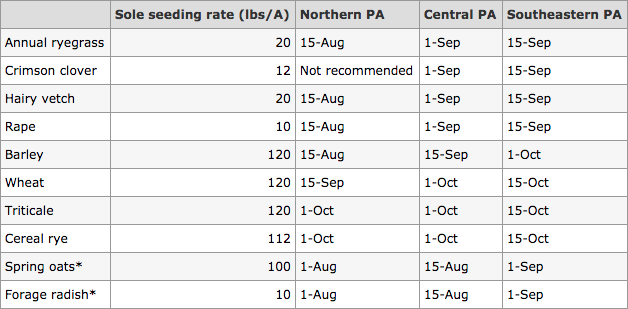Source: Penn State Extension
By Sjoerd Duiker, Soil Scientist
Small grain harvest has been completed in much of Pennsylvania and corn silage harvest is just around the corner, starting in southern Pennsylvania. One of the important principles of soil management is to keep the soil covered at all times, and to have continuous living root growth in the soil. This accomplishes many important objectives, such as erosion control, nutrient recycling and conservation, runoff reduction and infiltration improvement, soil organic matter maintenance and feeding of soil organisms. So it is important to think — what’s next after the harvest?
Options will vary according to climatic zone. According to the National Weather Service, the first freeze occurs around Oct. 20 in southeastern Pennsylvania, September 30th in central Pennsylvania, and September 20th in northern Pennsylvania (see below). It will be clear that cover crop options in the south are greater than in the north of Pennsylvania due to a larger window of seasonal temperatures.
Some successful species are listed in the following table, with approximate latest planting dates to avoid suboptimal performance. Performance and winter survival depend on many factors besides climate zone, such as temperature variability, precipitation, manure applications, organic matter content, soil fertility, etc., so these recommended latest planting dates are just first approximations based on our research.
The species can be mixed in various proportions. Try to select species that complement each other, such as a legume with a grass or an upright vs. viny cover crop.
While we give standard seeding rates for sole plantings in the table, determining appropriate seeding rates of each species in a mixture can be difficult. As a starting point, divide the normal seeding rate of a species if planted alone by the number of species in the mix. Then make adjustments based on the competitiveness of each species.
Certain species are highly competitive in a mix, including forage radish, canola and oats. Seeding rates of these species must be reduced more to prevent them from dominating the mixture. Successful seeding rates for these species in mixtures are 2-3 pounds per acre for forage radish, 3-4 pounds per acre for canola, and 20-40 pounds per acre for oats.
Legume components of a mixture, which tend to be weak competitors, are more safely kept towards their sole seeding rates to ensure establishment in the stand. If more than one highly competitive or poorly competitive species are included in a mix, divide these recommended seeding rates by the number of species in that group.
These are just starting points which need to be adjusted based on your preferences. The most important point right now is to get the seed and be ready to plant those covers immediately after harvest.

*Will winterkill throughout Pennsylvania.






Post a comment
Report Abusive Comment